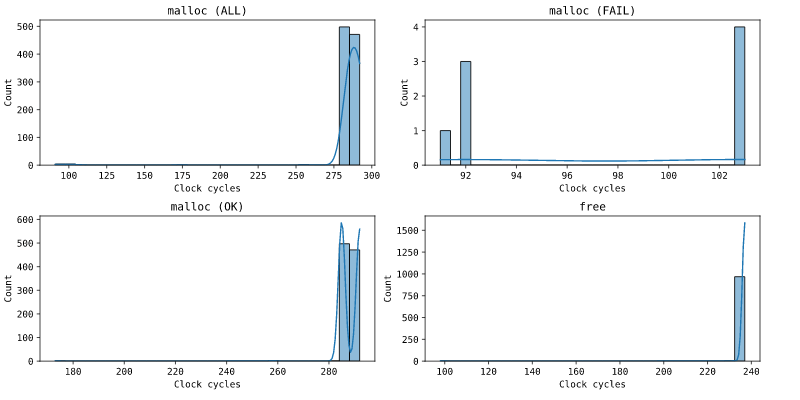2 stable releases
| 1.1.0 | Jan 12, 2024 |
|---|---|
| 1.0.0 | Dec 5, 2023 |
#839 in Memory management
98KB
2.5K
SLoC
An implementation of the Two-Level Segregated Fit (TLSF) allocator with optimized memory footprint
Design features
- The
allocanddealloc[^1] operations execute in bounded constant time (O(1)) - Good-fit strategy
- Immediate coalescing adds predictability and reduces fragmentation
For more details check the papers linked in the 'References' section
[^1]: in the worst case scenario, the realloc operation involves a memcpy operation, which executes in linear time (O(N))
Implementation features
- Reduced memory footprint compared to the original TLSF thanks to pointer compression
(
usize->u16) - Free of panicking branches when optimized, even when debug-assertions are enabled
- Adheres to strict provenance as checked by
miri
Rejected features
- A
GlobalAllocimplementation.
Rationale: it can be implemented on top of this library and every implementation needs to make
app-specific decisions like synchronization and whether to "forbid" realloc-like operations which
don't have bounded execution time by always triggering an OOM for them.
Those decisions are best left to the application author.
Limitations
- Can manage only up to 256 KiB of contiguous memory
- Can only allocate sizes of up to 62 KiB
Examples
The allocator manages mutably borrowed memory; the memory can even be stack allocated.
use core::alloc::Layout;
use core::mem::MaybeUninit;
use tlsf::Tlsf;
let mut tlsf = Tlsf::<1>::empty();
let mut memory = [MaybeUninit::uninit(); 256];
tlsf.initialize(&mut memory);
let alloc: &mut [MaybeUninit<u32>] = tlsf.memalign(Layout::new::<u32>()).unwrap();
assert!(alloc.len() >= 1);
alloc.iter_mut().for_each(|mu| { mu.write(42); });
When alignment is not important, the malloc method can be used.
The returned block will have a minimal alignment of 4 bytes.
use core::alloc::Layout;
use core::mem::MaybeUninit;
use core::num::NonZeroU16;
use tlsf::Tlsf;
let mut tlsf = Tlsf::<1>::empty();
let mut memory = [MaybeUninit::uninit(); 256];
tlsf.initialize(&mut memory);
let size = NonZeroU16::new(4).unwrap();
let alloc: &mut [MaybeUninit<u32>] = tlsf.malloc(size).unwrap();
assert!(alloc.len() >= 1);
alloc.iter_mut().for_each(|mu| { mu.write(42); });
The allocator tracks the lifetime of the initial memory pool and allocations cannot outlive it. This code does not compile
use core::alloc::Layout;
use core::mem::MaybeUninit;
use tlsf::Tlsf;
let mut tlsf = Tlsf::<1>::empty();
{
let memory = [MaybeUninit::uninit(); 256];
tlsf.initialize(&mut memory); //~ error: `memory` does not live long enough
// `memory` goes out of scope here
}
let alloc = tlsf.memalign(Layout::new::<u64>());
Due to this lifetime constraint, usage with #[global_allocator] requires that the initial memory
pool has 'static lifetime. An example GlobalAlloc implementation can be found in the thumbv7em
directory of this project's repository.
Parameters
The TLSF allocator has 2 parameters: FL and SL (see linked paper for further details). This
implementation hard codes SL to 16. FL can controlled via the FLL type parameter of the Tlsf
type. The table below shows the possible values of FLL and its effect on the allocator
FLL |
FL | MAX_ALLOC_SIZE |
HEADER_SIZE |
|---|---|---|---|
| 1 | 6 | 60 B | 36 B |
| 2 | 7 | 124 B | 72 B |
| 3 | 8 | 248 B | 104 B |
| 4 | 9 | 496 B | 140 B |
| 5 | 10 | 992 B | 172 B |
| 6 | 11 | 1,984 B | 208 B |
| 7 | 12 | 3,968 B | 240 B |
| 8 | 13 | 7,936 B | 276 B |
| 9 | 14 | 15,872 B | 308 B |
| 10 | 15 | 31,744 B | 344 B |
| 11 | 16 | 63,488 B | 376 B |
Requesting more than MAX_ALLOC_SIZE bytes of memory from the allocator will always result in an
OOM condition. Note that the effective value of MAX_ALLOC_SIZE is reduced when alignments greater
than 4 are requested via memalign due to potential padding needed to meet the alignment
requirement.
HEADER_SIZE is the fixed memory overhead of the allocator. There's a 4 or 8 byte of overhead for
each memory block managed by the allocator.
Performance
Benchmark configuration
- rustc: 1.74.0
- target:
thumbv7em-none-eabi - profile: release (opt-level=3, lto='fat', codegen-units=1)
- FLL: 2
Binary ("Flash") size
~1,594 B (.text section) if only memalign is used
~1,440 B (.text section) if only malloc is used
Measured using
#![no_main]
#![no_std]
#[no_mangle]
fn _start() -> [usize; 3] {
[
Tlsf::<2>::free as usize,
Tlsf::<2>::initialize as usize,
Tlsf::<2>::memalign as usize, // OR malloc
]
}
$ size -A binary
section size addr
.ARM.exidx 16 65748
.text 1594 131300
.debug_aranges 0 0
Note that these measurements used optimization for speed and are meant to give you an idea of the binary footprint of the library. Applying optimizations for size will obviously result in a smaller footprint.
Execution time
workloads:
memalign: N random-sized (<MAX_ALLOC_SIZE) allocations with random alignments (<= 32 B) until OOM
| Operation | min | max |
|---|---|---|
memalign (ALL) |
66 | 407 |
memalign (FAIL) |
66 | 125 |
memalign (OK) |
193 | 407 |
free |
96 | 337 |
"FAIL" indicates that memalign returned None; "OK" indicates that it returned Some; "ALL"
accounts for both cases.
![][memalign-histograms]
malloc: N random-sized (<MAX_ALLOC_SIZE) allocations until OOM followed by N deallocations in reverse order
| Operation | min | max |
|---|---|---|
malloc (ALL) |
91 | 292 |
malloc (FAIL) |
91 | 103 |
malloc (OK) |
173 | 292 |
free |
98 | 237 |
![][malloc-histograms]
The code used to make the measurements can be found in the thumbv7em directory of the project's
repository.
References
The design of the TLSF allocator is described and discussed in the following papers
- "A constant-time dynamic storage allocator for real-time systems."
- "Implementation of a constant time dynamic storage allocator."
- "TLSF: A new dynamic memory allocator for real-time systems."
which are available at http://www.gii.upv.es/tlsf/main/docs.html
Dependencies
~57–325KB

